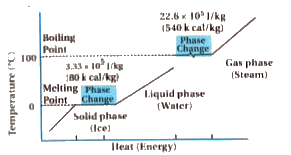What is latent heat ? Explain with example.Solution in Gujrati
Certain amount of heat energy is transferred between a substance and its surroundings when it undergoes a change of state. The amount of heat per unit mass transferred during change of state of the substance is called latent heat of the substance is called latent heat of the substance for the process.
For example, if heat is added to a given quantity of ice at −10∘C, the temperature of ice increases until it reaches its melting point (0∘C). At this temperature, the addition of more heat does not increase the temperature but causes the ice to melt, or changes its state. Once the entire ice melts, adding more heat will cause the temperature of the water to rise. A similar situation occurs during liquid gas change of state at the boiling point. Adding more heat to boiling water causes vaporisation, without increase in temperature.
The heat required during a change of state depends upon the heat of transformation and the mass of the substance undergoing a change of state.
Thus, if mass m of a substance undergoes a change from one state to the other, then the quantity of heat required is given by
Q=m L or L=Qm
where L is known as latent heat and is a characteristic of the substance.
Its SI unit J kg−1.
The value of L also depends on the pressure. Its value is usually quoted at standard atmospheric pressure.
The latent heat for a solid liquid state change is called the latent heat of fusion (Lf), and that for a liquid-gas state change is called the latent heat of vaporisation (Lv).
These are often referred to as the heat of fusion (Lf) and the heat of vaporisation.
A plot of temperature versus heat energy for a quantity of water is shown in figure,

When heat is added (or removed) during a change of state, the temperature remains constant.
In figure the slopes of the phase lines are not all the same, which indicates that specific heats of the various states are not equal.
For water, the latent heat of fusion and vaporisation are Lf=3.33×105 J kg−1 and Lv=22.6×105 J kg−1 respectively.
That is 3.33×105 J of heat are needed to melt 1 kg of ice at 0∘C, and 22.6×105J of heat are needed to convert 1 kg of water to steam at 100∘C.
So, steam at 100∘C carries 22.6×105 J kg−1 more heat than water at 100∘C. This is why burns from steam are usually more serious than those from boiling water.

Topper's Solved these Questions
- BOOK - KUMAR PRAKASHANCHAPTER - THERMAL PROPERTIES OF MATTEREXERCISE - Try Yourself (VSQs)84videos
THERMAL PROPERTIES OF MATTER
- BOOK - KUMAR PRAKASHANCHAPTER - THERMAL PROPERTIES OF MATTEREXERCISE - Information : Higher Order Thinking Skills (HOTS)8videos
THERMAL PROPERTIES OF MATTER
- BOOK - KUMAR PRAKASHANCHAPTER - SYSTEMS OF PARTICLES AND ROTATIONAL MOTIONEXERCISE - SECTION-F (SECTION-D) QUESTIONS PAPER1videos
SYSTEMS OF PARTICLES AND ROTATIONAL MOTION
- BOOK - KUMAR PRAKASHANCHAPTER - THERMODYANMICS EXERCISE - Question Paper11videos
THERMODYANMICS
Similar Questions
''Amount of heat is greater in hot body than cold body''. Check correctness of this statement.
03:46View SolutionWhat is the triple point ?
02:37View SolutionA rope of negligible mass is wound round a hollow cylinder of mass 3 kg and radius 40 cm. What is the angular acceleration of the cylinder if the rope is pulled with a force of 30 N? What is the linear acceleration of the rope? Assume that there is no slipping.
01:04View SolutionWhy is a steam burn more damaging than a burn with boiling water of the same ?
02:37View SolutionThe latent heat of fusion of a substance is always less than the latent heat vapourization or latent heat of sublimation of the same substace. Explain.
04:21View SolutionDefine latent heat. What are the S.I . Units of latent heat?
View SolutionWhat are the values of latent heat of fusion of ice and latent heat of vapourisation for water?
04:16View SolutionWhat is the difference between latent heat of fusion and latent heat of vapourisation ? Discuss the difference taking water as an example.
03:03View Solutionगुप्त ऊष्मा से आप क्या समझते है? गलन की गुप्त ऊष्मा तथा वाष्पन की गुप्त ऊष्मा को समझाइये।
View SolutionExplain the role of latent heat in the change of state of a substances
View Solutionगुप्त ऊष्मा की आण्विक मॉडल के आधार पर व्याख्या कीजिए।
01:49View SolutionExplain the role of latent heat in the change of state of a substance.
04:59View SolutionWhat is latent heat ? Give is units with the help of a suitable graph , explain the terms latent heat of fusion latent heat of vaporisation.
07:44View SolutionDefine latent heat of fusion and latent of vapourisation. Explain the variation of temperature with heat (energy) for water at one atmosphere with a graph.
05:46View SolutionWhat is meant by latent heat of vaporization
03:21View Solution

